Baked Pomfret Recipe is a vibrant dish that celebrates the rich culinary traditions of Indonesia. It showcases a tender succulent fish marinated in a fragrant blend of spices, herbs, and aromatics such as ginger, galangal, garlic, and shallots. The whole pomfret is baked to perfection with a slightly crispy exterior while retaining a moist, tender, and flaky texture on the inside. Often garnished with cilantro or lime wedges, this dish is served with rice or cooked vegetables, with spicy sambal on the side. This dish is a must-try for seafood lovers!
The recipe below for Baked Pomfret is an original, mélange recipe based on my experiences from India, Malaysia, Singapore, and Indonesia. It is reflected not only in the style of preparation but also in my use of ingredients. I have tried this method of preparation at hotels and resorts from the Arabian to the South China Sea. To be honest, they are all different, not only because of the fish but also because of the ingredients. But they all had that one common theme: freshly baked, spiced fish that tasted of warm seas, infused with the tropical tartness of freshly ground spice.
My Baked Pomfret recipe is a whole gutted fish baked in an aromatic marinade of ginger, galangal, dried shrimp, and other spices. Served on a bed of jasmine or basmati rice, this tender, aromatic fish uses very little oil in the preparation and relies instead on the moisture from the fish and the marinade to gently flavor while cooking. The fish can be marinated the previous night and baked in batches.
Pomfret as a variety of fish species:
To begin with, let’s talk about the Pomfret in the Baked Pomfret Recipe because this is a fishy story! Sorry, I couldn’t help the pun. To be candid, the colloquial use of the phrase ‘pomfret’ covers a variety of fish species:
- Butterfish: Butterfish is the most popular variety in Asian cuisine. There are a couple of varieties, but the more common one is the white or silver pomfret which can be found from the Arabian Sea to the South China Sea and as far north as Japan.
- Pompano: Pompanos are highly prized deep-bodied, toothless fish. The Black, Florida (or Golden), and Paloma Pomfrets are good examples, and they are found along shores in warm water locations.
- Pomfret: The actual pomfret is the Pacific pomfret, which can be found from Japan to Peru.
For this Baked Pomfret recipe, these fish are interchangeable. These seawater fish with a single bone have a flat body and a forked tail. As with most Pomfrets, these are best served whole, after removing the internal organs.
Differences between old ginger and galangal:
- Old or spicy ginger is drier and more fibrous. It is a much spicier elder to young ginger because of the increased presence of the compound gingerol, which is a potent antioxidant that reduces inflammatory enzymes. The increased presence of gingerol is attributed to the fact that this compound is concentrated in the skin and therefore, the tougher and more mature the root is, the spicier it will be.
- Galangal is a different ballgame. Although many people use old ginger as a substitute for galangal, it should be noted that there are differences in form and flavor.
- Galangal is more prevalent in Southeast Asian cooking than in Indian cuisine. While ginger is a mainstay of stir-fries and curries in China and India, the galangal is used to flavor the distinct soups and sauces of Indonesian, Malaysian, and Thai cuisines.
- While ginger (especially old ginger) can be powdered, I’ve always believed that galangal loses some of its flavor profile when subjected to powdering. It is a spice that tastes best when fresh and in small segments.
- Galangal has a piney and citrusy hue to its flavor, whereas ginger tends to be sharper and sweeter.
As I said, this combination of South and Southeast Asian ingredients gives my baked fish a sharp, sweet, yet citrusy bouquet when you take it out of the oven.
Why I think that you will love this Baked Pomfret Recipe:
- The recipe is straightforward and relies on the marinade to uplift the flavor.
- Not only is the Pomfret a healthy and sustainable fish but there’s also very little oil in the recipe to offset the natural omega-3 oils from the fish.
- There’s not much to clean up when you use foil, especially since the marinade does the work for you.
- I have used spices that complement the tantalizing flavor profile of Pomfret.
- Aromatic with dried shrimp, galangal, ginger, and shallot.
- Flaky and tender fish without the need for a sauce on the side.
- Better than restaurant-quality dishes at home.
Frequently Asked Questions:
- What are some other methods of cooking the pomfret fish?
- Air fry at 400 degrees F by wrapping the whole fish with the marinade in foil for 35-40 minutes.
- Steam: If you don’t want to bake, you could try steaming it. A word of caution, when you wrap the whole fish in foil, be sure to form a vent for the steam to escape. For a more Asian feel, try a bamboo steamer.
- Bake uncovered on a greased and foil-lined tray or broil for 20 minutes.
- Pan-fry or pan-sear with a little oil in a non-stick griddle.
- Grill: If you want to grill it, add some oil to the marinade. While grilling and/or searing this fish cooks the marinade and the fish, the additional marinade provides a fragrant and smokey flavor that enhances this Baked Pomfret Recipe.
2. What varieties of fish can I substitute using this Baked Pomfret recipe?
The choice of fish will not affect the recipe but will change the flavor profile. But the dish will be equally yummy!
- Tilapia
- Milk fish
- Red snapper
- Black Pomfret
- Cod
- Grouper
3. What makes Pomfret perfect for baking?
Unlike most other saltwater fish:
- It does not have a strong odor
- It is low in calories and fat
- It is rich in protein, which helps reduce the risk of cardiovascular diseases
- It contains high amounts of omega-3 fatty acids
4. How do I clean a whole Pomfret?
Large Asian stores offer fish cleaning services free of charge. However, I have included instructions on how to clean a whole fish.
- Scale the fish and trim or cut the fins and tail.
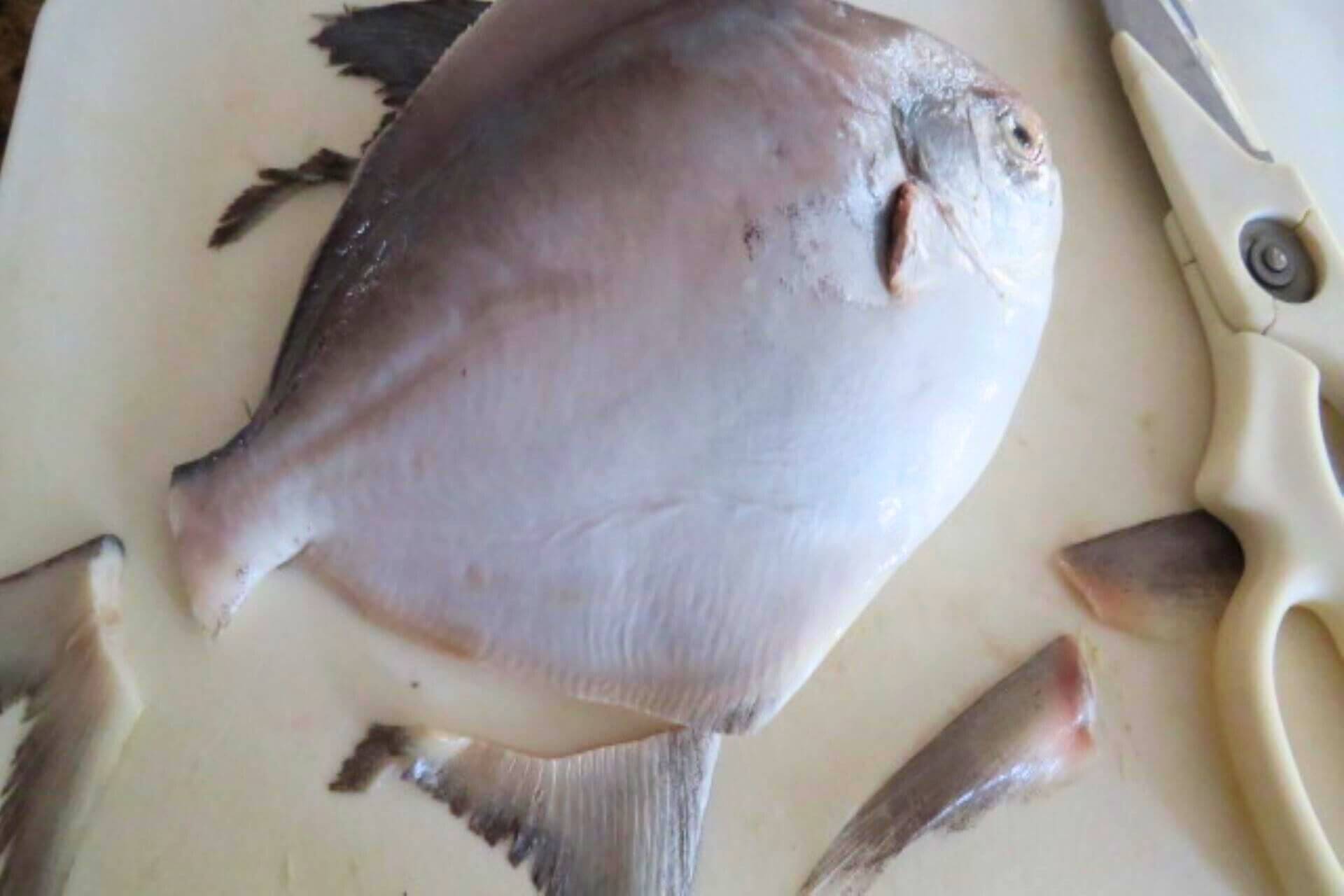
- Make an incision using a sharp knife by the lower fin. Use a spoon to scoop out the innards and gut the fish.
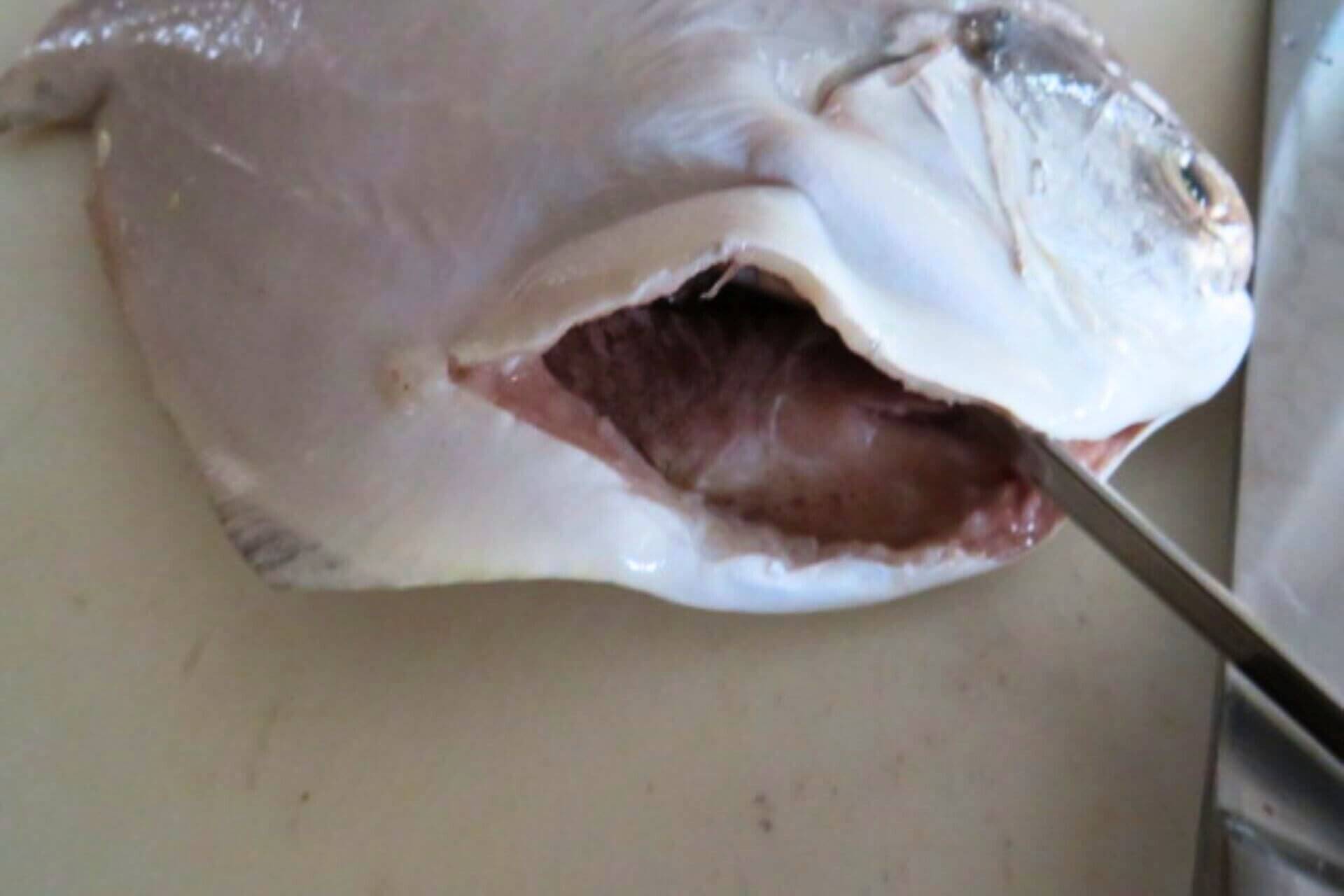
- Score the fish and make vertical or diagonal cuts along the sides of the fish by going deep down to the bones.
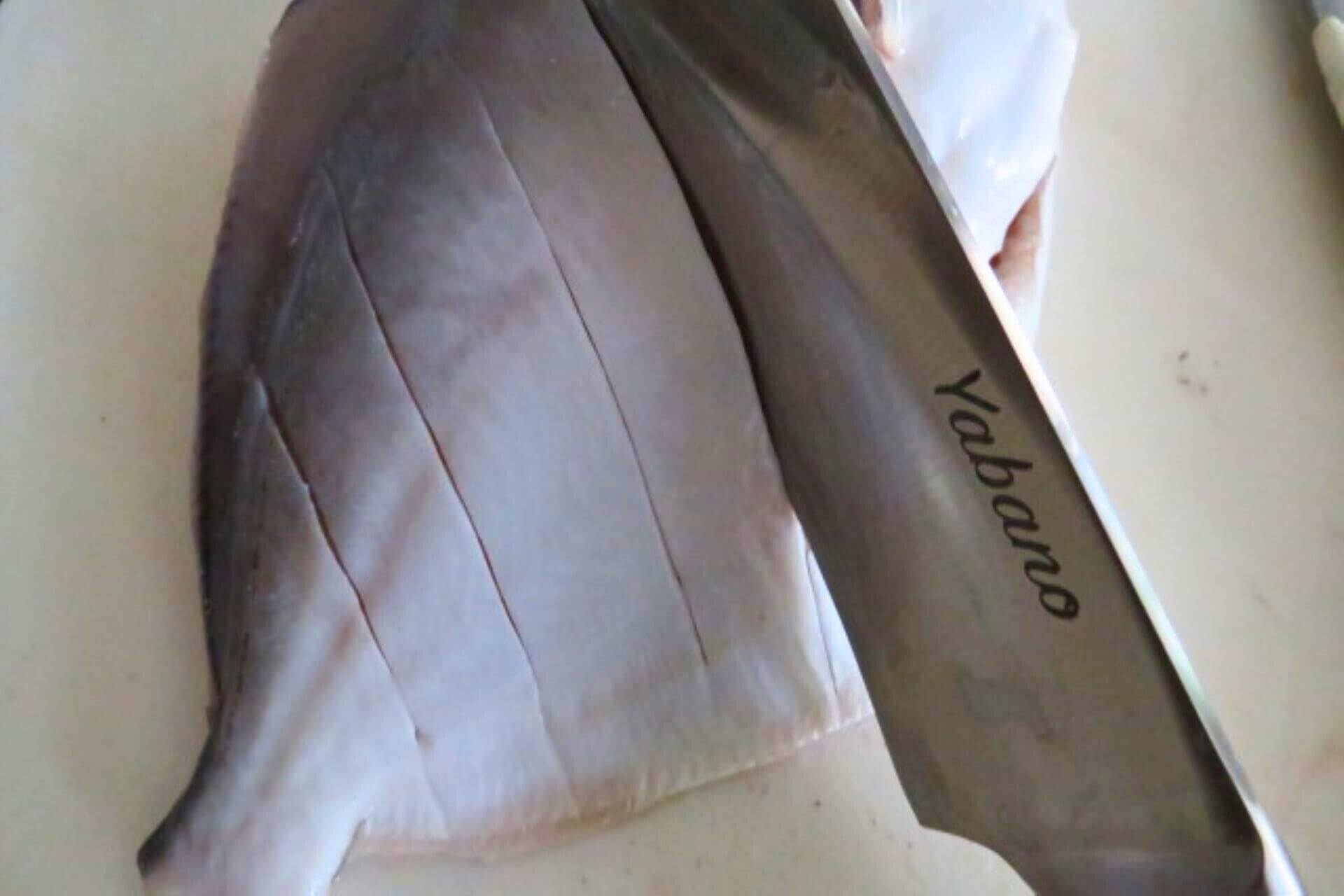
This post may contain affiliate links. As an Amazon Associate, I earn from qualifying purchases at no extra cost to you.
If you’ve tried this recipe or have questions, I would love to hear from you. Please feel free to share (below) your thoughts, comments, or any questions that you might have. And if you like my recipes, you could subscribe to my mailing list for the latest recipes that will be delivered to your inbox. From my pen to your table, Bon Appetit!
Ingredients:
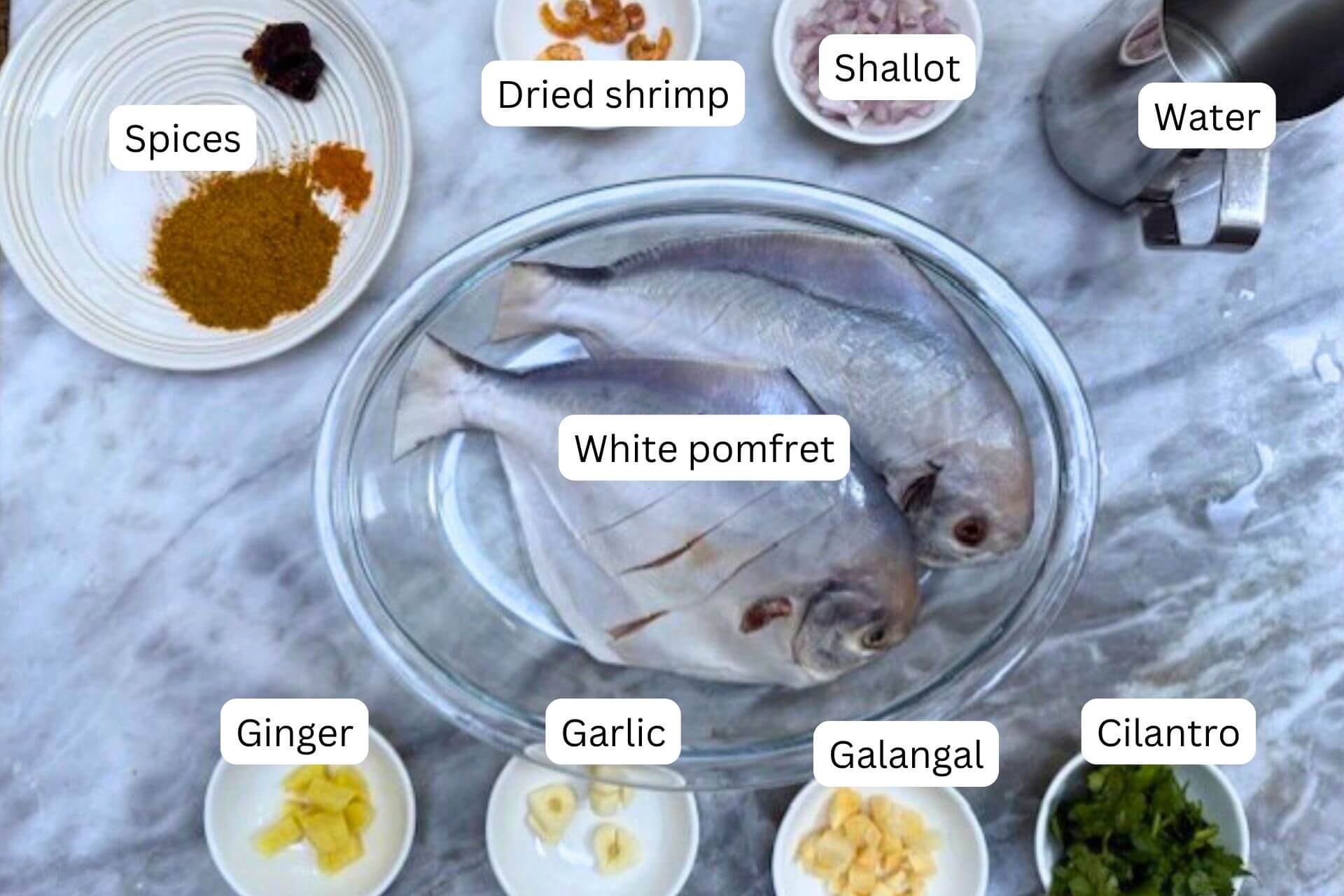
- Spices: yellow chili powder (substitute with red or cayenne powder), turmeric powder and tamarind (or use lemon juice)
- Aromatics: galangal, old ginger, garlic, shallot and cilantro
- White (or black) whole Pomfret, ( or use Pompano or Butterfish)
Here are the step-by-step instructions on how to make this dish. Please refer to the recipe card below for the measurements.
How to make the Baked Pomfret using my recipe:
- Place the ingredients for the marinade in a spice grinder. Pulse the ingredients to a fine paste. Add 1-2 tablespoons of water, if needed.
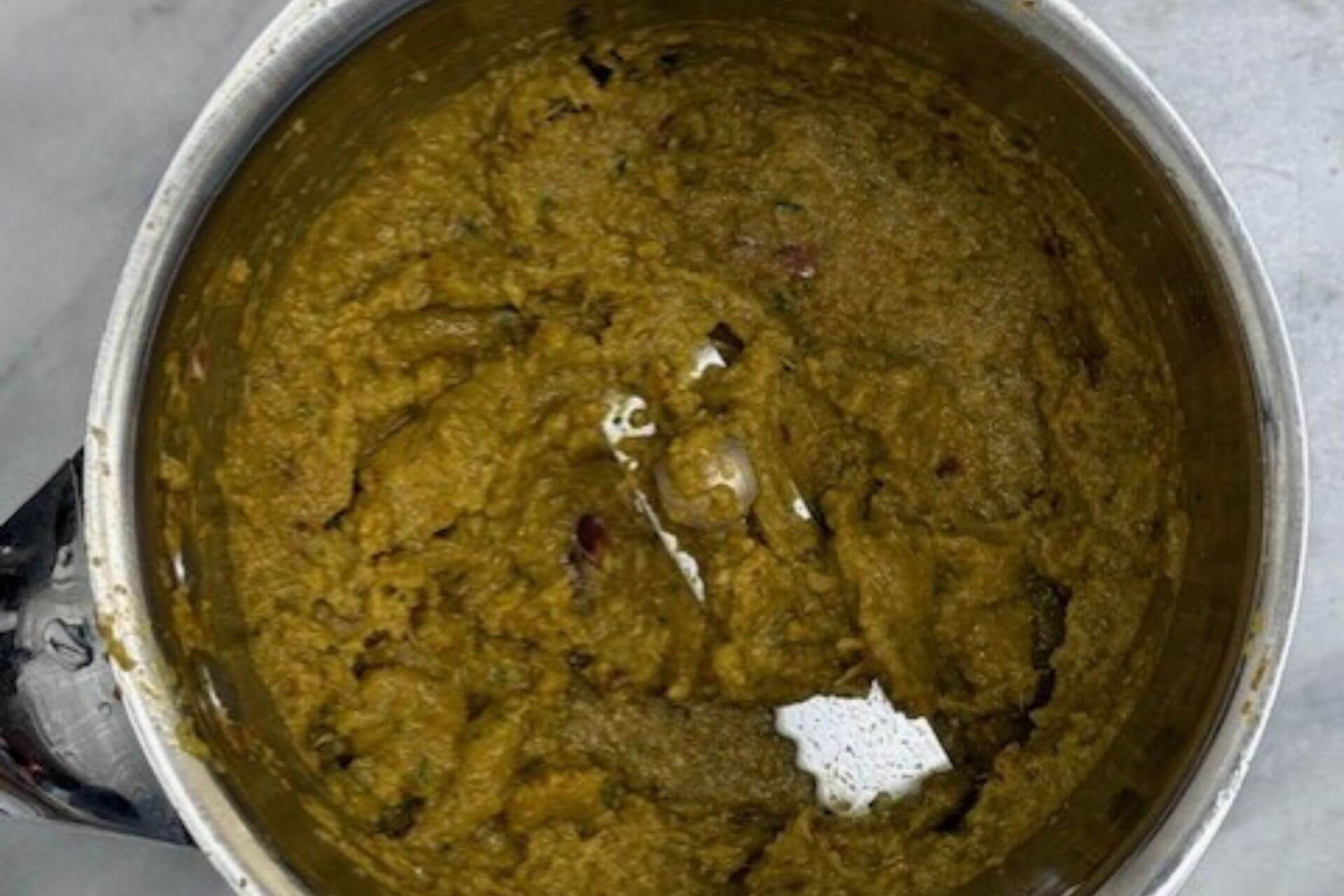
2. Slather the marinade on the whole Pomfret. Work the marinade into the incisions. Marinate the fish for at least an hour in sealed Ziploc bags in the refrigerator. Place each fish on a foil-lined tray, drizzle a teaspoon of peanut oil, and cover again with foil and bake them.
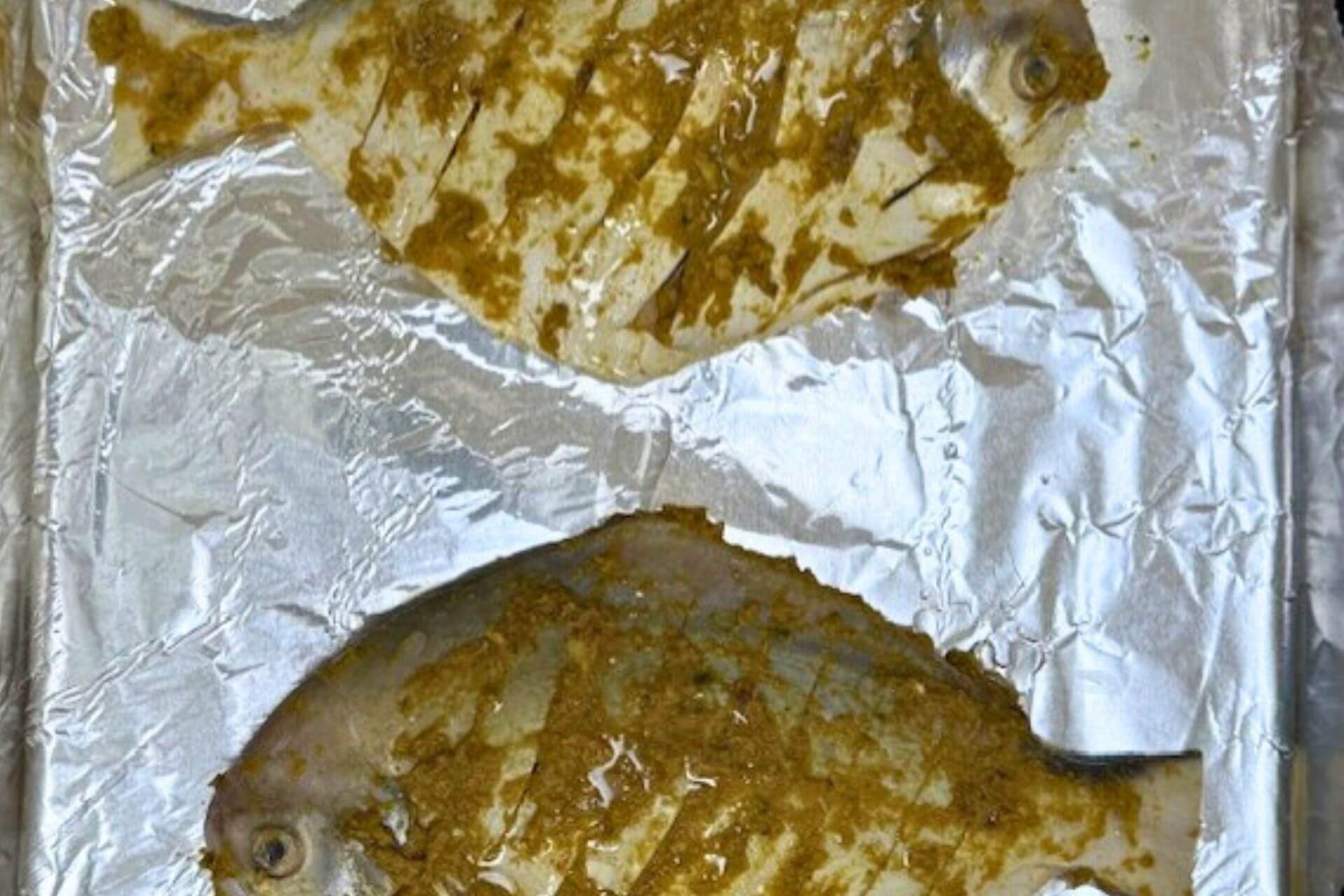
3. Remove the tray from the oven. Flip the fish over and bake again without covering them with foil.
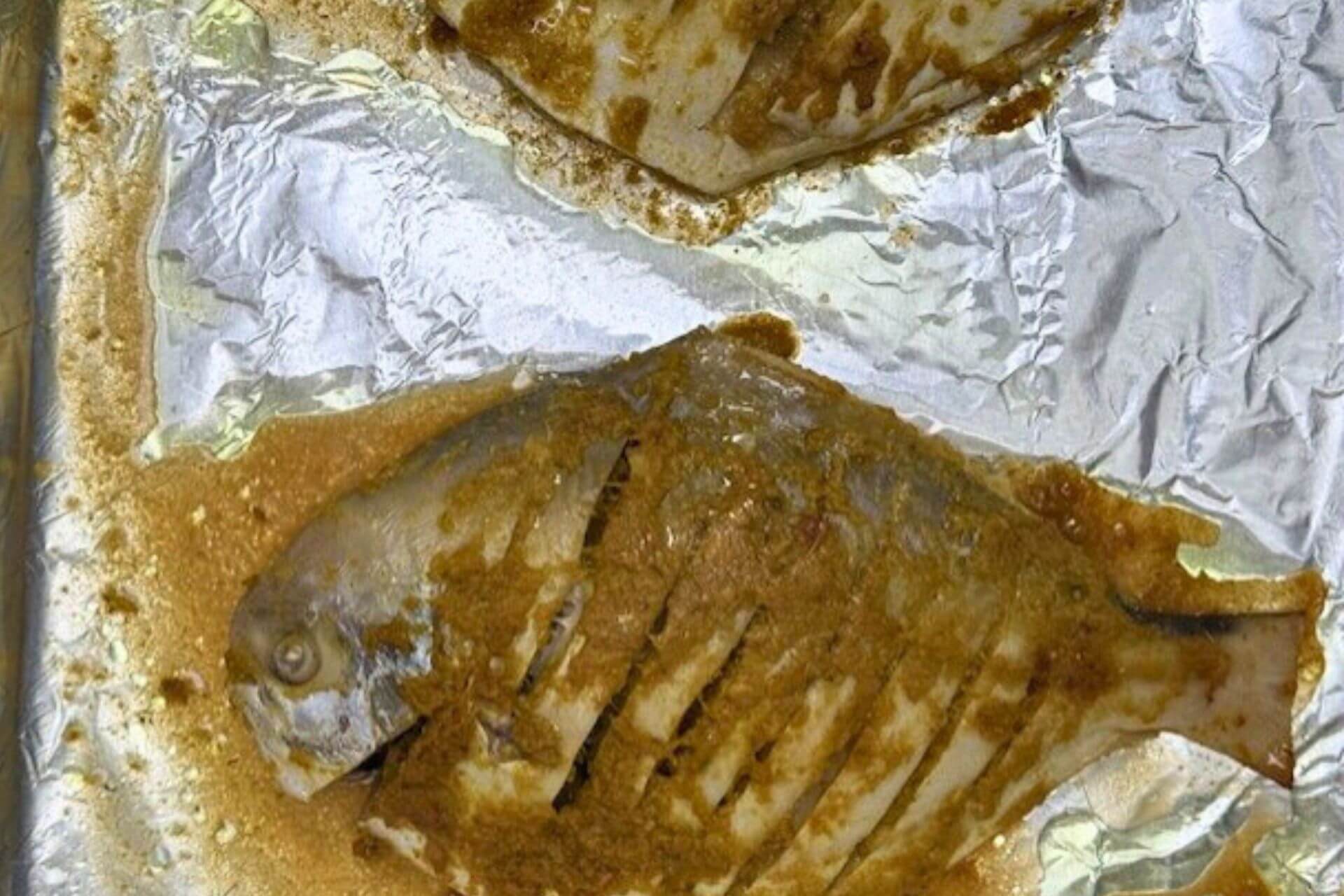
4. I garnished the fish with lime wedges and rau ram leaves (Laksa leaf/ Vietnamese coriander).
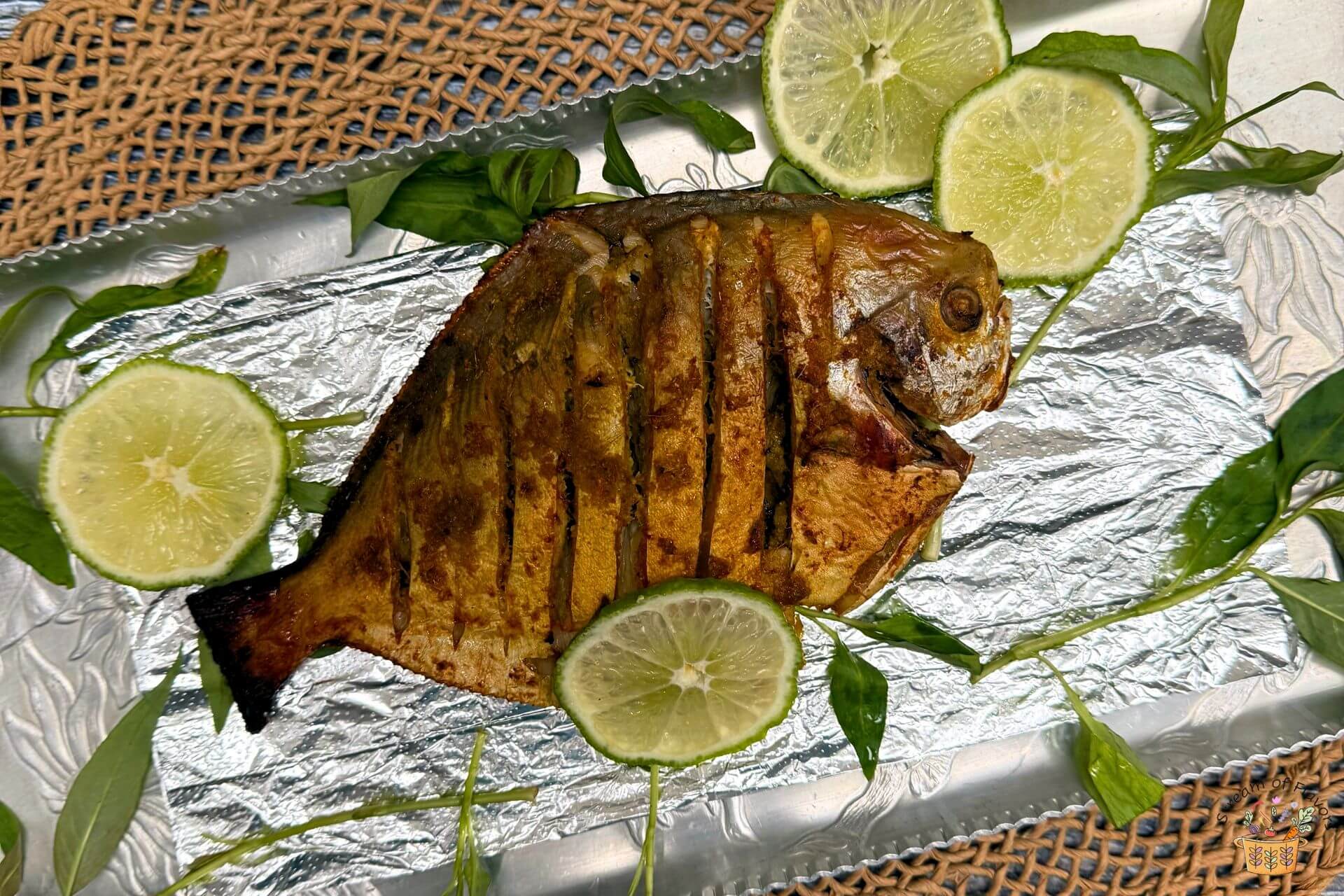
1. Pack the fish well in foil and seal it while baking to ensure the juices infuse into the fish.
2. To check for doneness, the fish must flake up when pierced with a fork or the internal temperature of the fish must be 145 degrees F on a meat thermometer.
3. Gently flip over the whole fish after 25 minutes of baking it using a flat spatula. Do not flip over the fish after completely baking it to prevent it from falling apart.
Serving suggestions:
I served the Baked Pomfret garnished with lime and rau ram leaves (Vietnamese coriander). It is often garnished with cilantro and served with rice or cooked vegetables with a side of sambal. I like serving it with Nasi Kuning and Rujak Recipe.
Storage:
This recipe for the Baked Pomfret allows you to refrigerate leftovers for 2 days or freeze them in airtight containers for 3 months.
Other fish recipes that you might love to try:
Baked Pomfret Recipe
Equipment
- spice grinder, oven
Ingredients
- 3 white pomfret whole, cleaned
- 1 tbsp galangal
- ½ tsp old ginger
- 1 clove garlic
- 1 shallot
- 2 tsp yellow chili powder
- ⅛ tsp turmeric powder
- ½ tsp salt
- 1 tsp tamarind
- 1 tsp dried shrimp
- 2 sprig cilantro
- 1 tbsp peanut oil for drizzling
Instructions
- Prepare the ingredients. Clean the Pomfret, make incisions, and keep aside.
- Place the ingredients for the marinade in a spice grinder. Pulse the ingredients to a fine paste. Add 1-2 tablespoons of water, if needed.
- Slather the marinade on the whole Pomfret. Work the marinade into the incisions. Marinate the fish for at least an hour in sealed Ziploc bags in the refrigerator. Preheat oven to 400 degrees F. Place each fish on a foil-lined tray, drizzle a teaspoon of peanut oil, and cover again with foil. Bake for 25 minutes.
- Remove the tray from the oven. Flip the fish over and bake again for 15-20 minutes without covering them with foil.
- I garnished the fish with lime wedges and rau ram leaves (Vietnamese coriander). Serve with Nasi Kuning and Rujak on the side.
Notes
- Marinate the fish for at least one hour or preferably overnight.
Nutrition


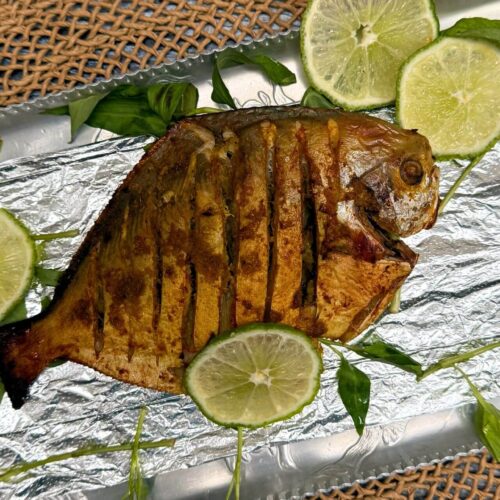
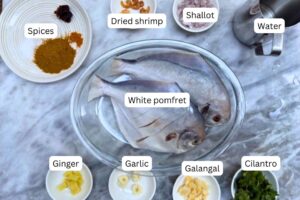
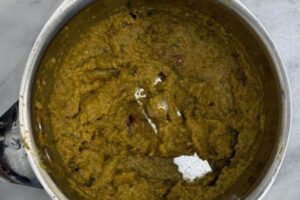
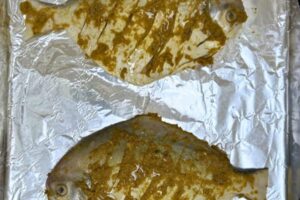
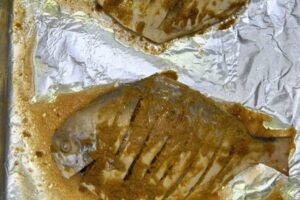
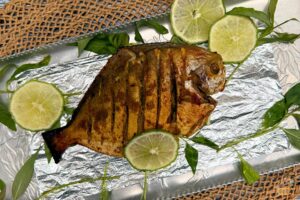




















this is such an impressive recipe!
This spice rub is really good!